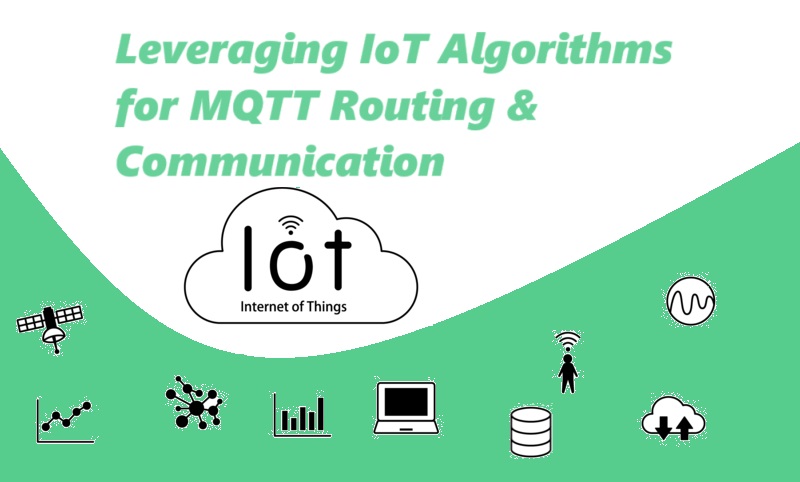The MQTT protocol is widely used in the Internet of Things (IoT) domain for its lightweight and efficient messaging capabilities. While MQTT itself is not a routing or communication algorithm, it can be combined with IoT algorithms to optimize data transmission within an IoT network. In this article, we will explore how you can leverage IoT algorithms for routing and communication with MQTT. in next section we are going to understand MQTT.
Understanding MQTT Protocol
The MQTT (Message Queuing Telemetry Transport) protocol is a lightweight messaging protocol designed for efficient communication between devices in a network. It was developed by Andy Stanford-Clark of IBM and Arlen Nipper of Arcom (now Cirrus Link) in 1999.
MQTT follows a publish-subscribe model, where devices or clients can publish messages to a broker, and other devices can subscribe to receive those messages. This asynchronous messaging pattern makes MQTT an ideal choice for resource-constrained devices with limited processing power and bandwidth.
One of the key features of MQTT is its lightweight nature. It uses a small packet size and minimal overhead, making it suitable for low-power and low-bandwidth networks. This efficiency allows MQTT to be used in a wide range of applications, including Internet of Things (IoT) devices, remote monitoring systems, and mobile applications.
MQTT uses a TCP/IP connection for communication and operates on top of the TCP/IP stack. It uses a simple binary protocol, which makes it highly efficient and easy to implement on different platforms. The protocol supports three levels of quality of service (QoS): QoS 0 (at most once), QoS 1 (at least once), and QoS 2 (exactly once), providing different levels of reliability and delivery guarantees.
Overall, MQTT is a versatile and efficient protocol that enables reliable and lightweight communication between devices in a network. Its simplicity, scalability, and low resource requirements make it an excellent choice for various IoT and messaging applications.
Leveraging IoT Algorithms for Routing and Communication with MQTT
Optimizing MQTT communication in IoT networks by integrating specialized algorithms for efficient routing and reliable communication, ensuring seamless data transmission and scalability in diverse IoT deployments. So we are going to discuss some key factors given below.
Topology Design
One of the key aspects of designing an IoT network is determining its topology. IoT algorithms can be used to design the network topology, taking into account factors such as node density, communication range, and network architecture. By strategically placing MQTT brokers and edge nodes within the network, you can minimize latency, optimize data transmission, and ensure scalability.
Cluster Formation
Clustering algorithms can be employed to organize IoT devices into clusters based on proximity, resource availability, or application requirements. By grouping devices into clusters, MQTT brokers can be strategically placed within each cluster to serve as communication hubs. This reduces the number of hops required for message delivery, improving efficiency and reducing network congestion.
Routing Optimization
Developing routing algorithms tailored to MQTT-based communication is crucial for efficient message propagation within the network. Factors such as network topology, link quality, and traffic patterns should be considered when selecting optimal routes for MQTT messages between publishers and subscribers. These algorithms ensure that messages are delivered through the most efficient paths, minimizing delays and optimizing network performance.
Load Balancing
Implementing load balancing algorithms helps distribute MQTT message traffic evenly across multiple MQTT brokers or nodes in the network. This prevents congestion and bottlenecks, ensuring reliable and efficient communication between IoT devices and MQTT brokers. By evenly distributing the load, the network can handle increased traffic and maintain smooth operation.
Quality of Service (QoS) Management
QoS-aware routing algorithms prioritize MQTT messages based on their importance or criticality. Messages with higher QoS levels, such as QoS 1 or QoS 2, may be routed through more reliable or low-latency paths to guarantee message delivery. By incorporating QoS management into MQTT communication, you can ensure that critical messages are given priority, enhancing the overall reliability of the system.
Dynamic Routing Adaptation
Dynamic routing algorithms adapt to changes in network conditions, device availability, or traffic patterns. MQTT brokers and edge nodes can dynamically adjust routing decisions based on real-time information, optimizing performance and resource utilization. This flexibility allows the network to adapt to changing circumstances and maintain optimal communication efficiency.
Security Enhancement
Security is a crucial aspect of any IoT deployment. Integrating security algorithms into MQTT communication helps protect against unauthorized access, data breaches, or tampering. Secure routing protocols and encryption mechanisms can be used to ensure the confidentiality, integrity, and authenticity of MQTT messages transmitted within the IoT network. By enhancing the security of MQTT communication, you can safeguard your IoT ecosystem from potential threats.
Conclusion
Combining MQTT with IoT algorithms for routing and communication can significantly enhance the efficiency, reliability, and scalability of your IoT deployments. By leveraging topology design, cluster formation, routing optimization, load balancing, QoS management, dynamic routing adaptation, and security enhancement, you can ensure seamless communication between devices and MQTT brokers in diverse IoT environments. This integration of MQTT and IoT algorithms empowers you to create robust and efficient IoT networks that meet the demands of today’s interconnected world.

